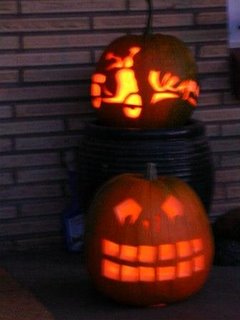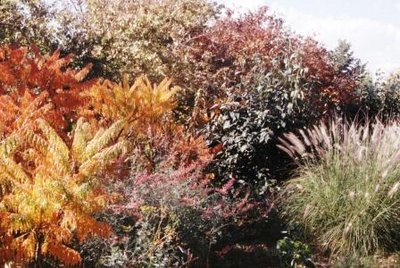Merry Christmas
Holiday Blizzard

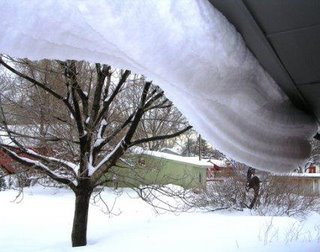
The predicted 8-10 inches of snow turned in to 24+ inches here at my house! We spent most of the day yesterday just digging out. The fascinating result of a true blizzard (winds of 35 mph+) are the drifts. Oddly shaped mounds and curtains of snow have formed around and over everything---quite the winter wonderland! Today the sky is clear and brilliant blue-time to go adventuring...
In my snow bound state I decided to re-read an old favorite: James Herriot's Every Living Thing. This is just one of a series of colorful and charming books that recount the exploits of Mr. Herriot as a country vet in post WWII Yorkshire. Herriot is a wonderful storyteller with a great sense of humor; he so obviously loves his animals, the countryside, and the peculiarities of his clients' owners. It's the perfect book to curl up with on a wintry day (or night!).
Gardening on Slopes

This is a perfect time of year to take a mental break from all of the holiday hubbub and think about your gardens and landscape. I've had several inquires about gardening on a slope, so here are some things to keep in mind while you dream and scheme:
The number one concern with a slope is preventing erosion or, in other words, promoting soil stability. First, determine if the slope needs to be supported artificially by means of a retaining wall(s) or a series of boulder groupings (a good solution for a more moderate slope and/or a rustic-natural appearance). This work should be done prior to any planting.
When you are ready to select plants, look for shrubs and perennials-especially- that have these characteristics:
- Plants that spread or have fibrous root systems.
- Plants that are evergreen or hold their foliage through the winter. Hint: think grey!
- Plants that are drought tolerant.
- Plants that are low maintenance. This is for your safety!
The goal is to cover the slope quickly and permanently. As always, a combination of contrasting plant sizes and shapes as well as foliage color and texture will make the garden more beautiful and interesting.
Even drought tolerant plants need water to become established (often for up to three years), so it's important to have a watering plan in place. Low volume drip, pop-up spray or leaky hoses that can be set to run repeatedly for short time periods are ideal for use on a slope. This type of system and application method will allow the water to soak in more easily and help prevent water run-off (and soil erosion).Take the time, now, to enjoy planning for the future!
Exciting News!

I am pleased to announce that I have been invited by Denver Botanic Gardens to participate in their "garden gallery" tour on August 4th, 2007. This will give you an opportunity to visit my garden and see my artwork as well. I'm pleased with the August date --- it will give my grass garden and container plantings a chance to really grow in---things should be looking great then!
My challenge will be to figure out a clever way to display my fiber pieces outdoors. All suggestions welcome!
Sneak preview: Photo above shows a detail of "Cultivation." Stay tuned for more information on this event!
The Big Melt

Wow! What a difference a week makes! This photo, taken a few days ago, shows the start of the warm up. What caught my eye was the thin blue line of water being exposed as plates of ice separated. Inspiration for a new art quilt, perhaps?!
The weekend weather promises to be delightful. I'll be busy helping my daughter move to her new digs (an empty nest once again!) and stringing a few twinkly white lights around the yard. I may also putter a bit in the garden shed and get my tools cleaned up. Here's what I do:
- Scrub with soapy water.
- Oil metal surfaces with WD-40.
- Rub wooden handles (unpainted) with linseed oil - wipe any excess.
I have my few favorite tools that I use a lot, so I try to keep them happy!
Meet. . . . .Mahonia!

Mahonia is a broad-leaf evergreens (as opposed to a needle type conifer such as pine or spruce) that do especially well in the mountain west. They tolerate both full sun and full shade, although I think the ideal siting is in morning sun with afternoon shade. Mahonia is also an ideal choice for dry shade---one of the toughest conditions to select plants for. Commonly known as Oregon grape holly, this plant is available in three different sizes; standard (M. aquifolium) is 5'-8' tall by 5' wide, compact (M. aquifolium 'Compacta') is 3'-4' tall and 4' wide, and creeping Oregon grape holly (M. repens) is 12"-18" tall and is a groundcover type-plant them about 2' apart and they will fill in after 2-3 years (fairly slow to get established).
I love this plant! It has glossy green leaves during the growing season that turn to a burgundy-bronze in the winter. Clusters of small, yellow flowers in mid-spring are followed by blue berries that are a great favorite of birds---I see young Flicker woodpeckers chowing down on them in the summer.
So if you want a xeric, versatile evergreen, choose Mahonia!
Can You Say Brrrrrrrrr?!

We awoke this morning in beautiful Wheat Ridge, Colorado, to our coldest temperatures of the season---a cool 7.6 F! But the snowstorm had cleared out and left a beautiful blue sky. The white blanket of snow that was left behind has such a calming affect; everything seems clean and quiet and relaxed (as long as you aren't out there driving on the icy roads, that is!). My neighborhood consists of little brick ranch style houses built in the early 50's. In the wintertime, when snow is all around and the sun is low, it looks like a vintage Christmas card to me, and I love it.
Weekend Fun

What a great holiday weekend! I got to visit with several friends that I don't see nearly enough, spend time with my family, and, yes, even get in some holiday shopping!
My daughter and I had a fun outing on Saturday: a "photo safari" to Echter's Garden Center. We each took our digital cameras and meandered through the store taking pictures of flowers and holiday decor. They even have an area set up specifically for use as a family photo backdrop! As amateurs working in low light (it was late afternoon) and without tripods, we got our share of blurry images. All of those little fairy lights and sales tags were a challenge, too!
This photo of an orchid was one of my successes.
Turkey Fry

Well, I was all set to create a pictorial posting of our annual Thanksgiving turkey fry, but I only got one photo before I got caught up in all of the activity! We use about three gallons of oil in our frier, which we set way out on the edge of our driveway, away from the house. We also take the precaution of setting it on a piece of drywall, which absorbs the oil mess and is relatively non-flammable.
The real fun happens when our friends stop by to have their turkeys fried. We nibble on snacks (which our guests contribute as the "price of admission"!) and visit until their turkey is done cooking (about 45 minutes for a 12 lb bird), and then they're off and the next group arrives. It's a revolving door of food and fun! Our own turkey is the last one in the pot, late in the afternoon, and then we settle in for a quiet family dinner.
Get 'er Done!
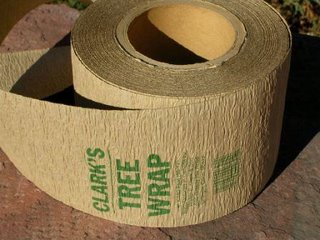
Need a light chore to help you work off your turkey feast? If you haven't done so already, then get out there and wrap your trees. Young trees that haven't yet developed their "corky" or mature bark are very susceptible to winter sun scald. The lack of foliage, low angle of the sun, and reflection off of snowy ground all contribute to damage tree trunks. This is a particular concern at our altitude, of course, and young honeylocusts and maples are especially at risk.
So here are a few tips:
Use a product made for this task---see photo. It's not expensive, and it can be reused.
Start at the base of the tree and wrap in an overlapping spiral (to shed moisture, like a shingle)up to the second tier of branches.
Secure the ends of the wrap to itself (not the tree) with duct tape, a small office type clamp, or staples.
Apply at Thanksgiving, remove at Easter.
Fall Fandango

I am still enjoying the Fall foliage, even though most of it is on the ground now. I move piles around from here to there, using them as a loose, light mulch. The artwork, pictured above, was inspired by the idea of layers of fallen leaves and their dancing journey to the ground.
To see more of my fiber art, please visit my website.
My Favorite Tree

This photograph, taken about a week ago, is of my favorite tree, an apricot. It doesn't have a great shape---too much storm damage and amateur pruning over the years--- nor does it provide a great fruit crop---too many late spring freezes. But it does have a lot of sentimental value.
About 18 years ago my daughter and I took a "girls only" drive down to southwestern Colorado to visit my mother and grandmother. My grandmother had a fabulous garden - everything from perennials to numerous fruit trees (apricots in particular) and vegetables. She gardened on about 3/4 of an acre in a small rural town and she loved to experiment. Although she'd had a career in high fashion, she had since become a town character with her hair always done up in an enormous French twist and her daily gardening uniform of blue Lee overalls and canvas Keds sneakers. Anyway, this particular visit was in early Spring, and my grandmother convinced me that I had to take home one of her apricot tree seedlings. She had a habit of tossing her fruit pits out the back kitchen door and into her rose garden for the birds and squirrels to eat. Ocasionally, some of those seeds actually germinated and grew, and she would give them to friends or transplant them to other locations on her property. I decided that a 4 foot whip could easily fit in the back seat of my little Mazda, so why not? Wanting to impress my grandmother, I quickly balled and burlapped (or sheeted, more precisely) the little tree---the only time, before or since, that I've actually done that!
Well, as the photo shows, Grandmother's apricot has done quite well here. It remains a joy to behold throughout the seasons, and is a wonderful reminder of one of my all time favorite people.
Please share the stories of your favorite plants here, too.
Anticipation...

...can be a negative thing or a positive thing. Case in point: The 200 tulip bulbs that I ordered last summer arrived last week. I had ordered them, somewhat on impulse, in the hope that I would feel compelled to plant them once they were sitting on my doorstep (I am often "too busy" to shop for, much less plant, bulbs in the fall and always regret it in the spring). Well, I was bemoaning my fate---this "horrible" planting chore---for several days. I knew that I would have to do it Saturday before the cold and wet weather hit us on Sunday. Lo and behold, I had an absolutely delightful afternoon planting those silly bulbs!! The day was fresh and warm, and the soil moisture content was perfect for easy digging. I got into that peaceful zone that only gardeners can know. All of that wasted energy spent on negative anticipation has now flipped---I am so looking forward to my new crop of tulips next spring!
Lesson learned? Get out there - in the garden - and get transformed.
Winter Watering Tips

This info is just slightly dated, but great advise nonetheless. It was adapted from "Front Range 2006 Precipitation," by Carl Wilson, Denver County Cooperative Extension, The Green Scene Newsletter (October 2006):
September was the eleventh month in a row with below normal precipitation in Denver and ended with precipitation for the year at 7.15 inches below normal, according to the National Weather Service. Normal precipitation through September is 13.21 inches.
What does this mean for plants?
- Plant roots require moisture throughout the growing season and in the case of perennials and woody plants, throughout the year. Don't be thrown off by local precipitation rates that may imply adequate moisture when totals may have been inflated by single events.
- Dig down and check that adequate moisture is present throughout the soil profile to an 8-12 inch depth.
- If moisture is not found, water the plants.
- Make sure that woody plants in particular enter the winter months with adequate moisture and that as winter progresses, plants are monitored and watered as needed.
- Pay special attention to recently installed plants and evergreens.
'Prairie Sky' switch grass (Panicum virgatum 'Prairie Sky')
Don't do That
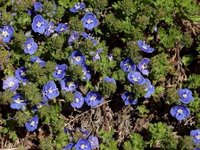
In yesterday's post extolling the virtues of late fall foliage I showed a photo of a Vanhoutte spirea. This is a lovely example of an arching, or fountain shaped, plant form. This plant form needs plenty of space to show off, and is ideally placed as a single specimen. However, just don't plant it in the lawn as my photo showed! Why? Well, not only is it a maintenance nightmare having to mow and/or trim around the base of the plant, but you also risk damaging it as a result. A better idea? Create a planting bed and combine the spirea - or any plant with an arching form - with a very low groundcover. This will show the shrub to its' best advantage and allow for easier maintenance.
What would I combine with a Vanhoutte spirea? How about creeping wooly speedwell (Veronica pectinata), shown here. It's drought tolerant - like this particular spirea - has small blue flowers in early summer, and is often evergreen (purple-ish grey) in the winter. Voila', a much better solution!
Treat Yourself
Would you like to be notified via e-mail whenever I create a new post here? Then just click on the "subscribe" button on the right to get set up. Let your friends know, too, about my newly improved, user friendly blog --- and thanks for reading!
Still in Leaf!
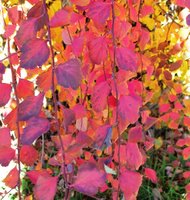

Prior to our recent high winds there were a number of deciduous woody plants throughout my neighborhood that were still holding on to their foliage---most of them sporting their peak autumn color. Some of these shrubs include burning bush (Euonymus alatus), Vanhoutte-or bridal veil- spirea (Spiraea x vanhouttei) shown here, St. Johnswort (Hypericum), Gro-Low Sumac (Rhus aromatica 'Gro-Low') and many roses (Rosa sp). Ornamental pear trees (Pyrus calleryana) are now in their prime with wonderful red foliage, and my apricot tree (Prunus) was cloaked in gold.
So if you want extended foliage color and texture deep into the fall you might consider adding some of the above mentioned plants to your landscape. In fact, most of these plants are pretty resilient to damage from the early, heavy wet snows that we can sometimes get (with the exception, perhaps, of the pear trees).
Photos taken today show Vanhoutte spirea.
Upcoming Classes and Events
A heads up for those of you who might be interested in learning more about landscape design and/or landscape renovation with a focus on saving water. I will be teaching several classes early next year at Denver Botanic Gardens and I encourage you to register soon either on-line or by phone at 720-865-3580, as classes fill quickly. Click on the links for more info and/or registration for specific events.
The first class, Landscape Design Theory, is on January 13 (Sat), from 9am-4pm. This is an all day lecture that includes a review of historical and contemporary design styles, the elements and principles of artistic design and how they relate specifically to the garden, and the design process used by professionals.
Also on January 13, DBG will have their kick-off for the series of water- smart lectures that they are doing in conjunction with Denver Water. David Salman of Santa Fe Greenhouses will be the guest speaker and there will be tables staffed with industry pros that can answer your questions about plants, irrigation, etc. You will also be able to register for and schedule a future consultation with a landscape designer --- another program that I am involved with!
On February 3, as part of the above mentioned water-smart series, I will be giving a lecture from 10am-noon on renovating your existing landscape to make it more water efficient.
Finally, Lush Landscapes with Less Lawn will be coming on April 7, 9am-noon. This one is not in the catalog yet, but I'll keep you posted.
I hope you can join me for one or more of these events. I really enjoy teaching and public speaking, and my classes are fun and informative---if I do say so myself!!
Great Snow

That big dump of wet snow last week was just the thing our gardens needed! There is no way to artificially apply a long, slow drink of water like that. Luckily, none of my plants were damaged, although many of them still have their foliage. Most of the broken branches I've seen have been from the usual suspects---Siberian elms, poplars, or silver maples. Avoid those trees like the plague! Yes, they're cheap and yes, they grow fast, but they just don't hold up well in our climate.
Snow squirrel sculpture by Erin Chilvers, October 26, 2006. You're never too old to play in the snow!
Great Nursery
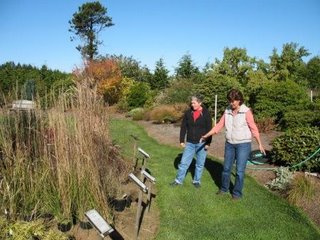
During my vacation I got to visit a small nursery in McKinleyville, CA, Singing Tree Gardens . They specialize in azaleas and dwarf conifers but feature many other interesting plants as well, some that may translate to our area if you have the right microclimate. Their retail area is very charming in that it is set up as a display garden to be shopped from, as opposed to plain rows, and grassy paths instead of gravel. Fun and appropriate given the small setting.
In this photo I'm using my patented "It'll get about this big" gesture!
I'm Baaaaaack!

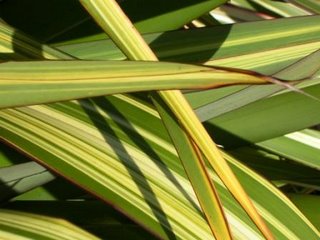

Wow! Nothing beats a great vacation for refreshing and reinvigotating your attitude! I had a great time in far Northern California (locals call it "The North Coast") enjoying the sights, eating fresh seafood, playing with fabric, and enjoying the company of my terrific sister and brother-in-law.
Photos include: 1. Ocean view South of Ferndale, CA. 2. View of a classic garden of lavenders, grasses, barberry, heaths and heathers. 3. Foliage of the ubiquitous New Zealand Flax (Phormium).
Gone Fishin'

This is just one of the many fabulous beach vistas I'll be enjoying during the next two weeks; I'm headed off to beautiful Humboldt County in Northern California. I'm hoping to provide some posts and pictures featuring some of the beautiful native and cultivated plants/landscapes of that region---so different from our own. But my top priority is to help my sister celebrate her 5oth birthday in grand style, so we'll see!!!
Perfect Timing
Boy, did I get lucky! Last week I scheduled my lawn to be aerated today. With yesterday's moisture, the crew was able to pull nice, deep plugs from my sod. If you haven't aerated yet this year, or you had a lot of compaction on your lawn areas over the summer, you might want to aerate this month. Aeration in Spring and/or Fall is one of the best things you can do to promote better water and air movement into the soil. This is also the best month to give your bluegrass or fescue lawn its last dose of fertilizer.
Meet . . . Rhus!

Rhus, or Sumac, as they're known, are common shrubs in our area and popular for their brilliant red and orange fall foliage. They are all drought tolerant and do well in poor soils. Heights can range from about 2' to 10', so make sure you have the right plant for your specific planting location. Unfortunately, both the Smooth Sumac, Rhus glabra-such as the cutleaf variety shown in this photo, and the Staghorn Sumac, Rhus typhina, tend to sucker and can become invasive.
One of my favorites is the Grow- Low Fragrant Sumac, Rhus aromatica 'Grow-Low'. It's an excellent xeriscape plant with a low, broad form (2'x6') that works well with other shrubs or perennials. It also has small, fuzzy red berries that the birds love. Try this plant with Pinon pine and rabbit brush.
My Favorite Rake

We all have our favorite tools---whether it's in the kitchen, the garage, or the garden. Tools that are the right size or the right weight or are just beautifully crafted, like this bamboo rake. It's really nothing fancy, and it would probably be too heavy for me to use for a long period of time. But I like the sound it makes pulling through the leaves and across the grass. And I like using a tool made of organic materials when I work out in the garden. It just fits.
Don't Miss It!

Fiber Translations is an exhibit of fiber art by four Denver area artists (including yours truly!) that is now on view in the Radius Gallery at Lakewood's Heritage Center. The work includes both two and three dimensional pieces that reflect the artists' interpretations of the seen and unseen world around us. Each artist has a unique voice and a unique vision---individual translations, if you will. My work is inspired, of course, by both the natural and man-made landscape; colors, themes, and assemblage techniques all reflect the ever changing organic world in which we live.
The gallery is located in the Visitor Center at 801 S. Yarrow (Wadsworth and Ohio). Hours: 10 am to 4 pm, Mon-Fri, and noon to 4 pm Sat.
Take a Seat . . .

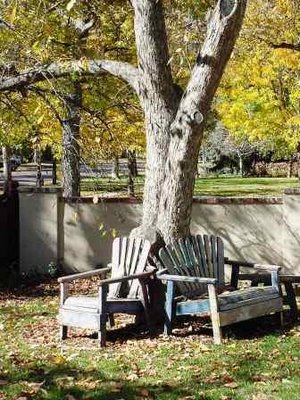
. . . Any seat! One of the most valuable components of a landscape, whether large or small, is destination seating. Every garden should have a spot where you can sit and relax, dream and scheme! More importantly, a place to stop and view the garden away from your main window or patio/deck view gives you a whole new vista to appreciate. It's almost like getting two gardens for the price of one!
Another reason to create a destination seating area is that it will pull you into the garden. There's nothing like actually walking through the space, instead of just viewing it as a static "picture", to get you interacting with nature again.
And finally, a pair of chairs - like those in the Denver garden (bottom photo), a teak bench - like the one in my garden (top photo), a large boulder, etc. can also act as a focal point in the garden. Try and select a seat that is harmonious in color, materials, or character to other furnishings in your landscape. Choose materials that are low maintenance or attractive to you in their rustic state. Also think about weight - you don't want something that will end up in the next county every time the wind blows.
Now sit back and enjoy!
Save Water
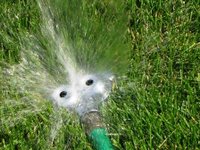
As we enter the month of October it's time again to ratchet down your water use in the landscape. Historical data shows that lawns need only 1/2" of water per week this month. Reset your clock or reset your timer---just be ready to use less water this month!
Got Color?
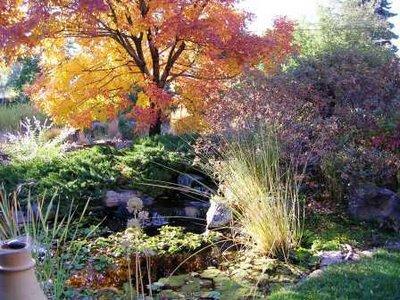
The colors of Autumn are so engaging, so enchanting. I just want to look and look and look - before it's all gone for another year. Fall color is special because it is such a brief sojourn, for one, and also because of the light quality at this time of year. The sun's lower angle really seems to illuminate plant foliage and give it a glow beyond its' fiery colors.
Hope you enjoy this view from my patio...
Attack!

We all have our enemies. Dandelion seed blown in from the empty lot across the street, elm trees "planted" by the birds, aggressively "happy" perennials that we introduced to our gardens ourselves (can you say "yarrow"?) Dealing with these intruders is a fact of garden life---it pays to keep after them throughout the growing season before they get totally out of control and you get totally discouraged. But now, now is the time to hit them with a shot of herbicide! Perennial weeds are moving food reserves down to their roots now, so any systemic herbicide will be pulled down to the roots more efficiently now too. Heh-heh-heh!
Moving Time

Fall is not only a great time for installing new plants, it's also a great time for moving existing favorites. If you have perennials that flower in spring or early summer and need to be divided or moved to a better location, then now is the best time to do it. (Wait to transplant your summer and fall flowering plants and ornamental grasses until next spring.)
One plant, in particular, that should only be moved in the fall is the Peony, Paeonia. Peonies will not flower well is their site has become too shady, or if they were originally planted too deep. Dig up and cut apart the fleshy tuber so that each section has 3-5 eyes or buds and about 6" of root. Replant pieces no more than 1-2" below the soil surface. Peonies grow and bloom best in full sun and are moderately drought tolerant. Plant in deep, rich, well draining soils.
Autumn Joy

Nothing beats the smell of roasted green chiles. One of our favorite Autumn traditions is to stop by a roadside stand, pick out a bushel of chiles, and watch as they're flame roasted in an open tumbler. What will it be this year---poblanos? Big Jim's? Hatch's? Medium, hot or extra hot? This year we choose poblanos, with their dark green, thick flesh and medium heat. The ride home in the car with a big batch of chiles, still steaming in their plastic bag, is pure heaven. We divvy up the chilies into small batches of 3-4, put them in sandwich size freezer bags, and fill up half of our freezer! We'll enjoy them for most of a year in all kinds of delicious dishes.
Treat yourself to some Autumn joy---fresh roasted chiles!
Local Growth
Ever wonder where your plants come from? Colorado has a thriving greenhouse and nursery industry to provide plants that are adapted to our climate and soils. Sure, a lot of our evergreens come from big California or Oregon growers, like Hines and Monrovia, and they provide a good product. But if you shop at a local, independent garden center, you'll find many, many "home grown" plants to choose from.
This week I had the opportunity to visit Boxelder Creek Nurseries in Hudson. This is the state's largest wholesale nursery at 870 acres. There are over one million plants from seedlings to 6" caliper trees in the ground, and thousands more in containers or B&B. They grow over 1,100 varieties (yes!) of deciduous and evergreen trees, shrubs, perennials, grasses, and vines. There's nothing like seeing row after row of beautiful plants to get excited and inspired about gardening.
So shop locally and support your Colorado growers!
Meet . . . Ceratostigma!

Ceratostigma plumbaginoides is the toungue twisting Latin name of Plumbago. This hardy groundcover has stunning blue flowers from August through September, and beyond! The late season blooms are accompanied by brilliant ornage-red foliage for a superior fall color display. Plumbago grows 8"-10" tall and will slowly spread. It's adaptable to most soil types, moderate to dry watering conditions (though not a good choice for super-hot locations), and full sun to shade. What more could you ask for?
Enjoy the View
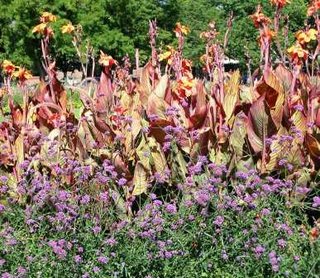
I spent a delightful Sunday morning with my family, strolling through Wash Park. We "ooohed and aaahed" over the wonderful flower displays. The City of Denver does an amazing job every year creating dramatic and showy exhibits with annual bedding plants. They have gotton wise to incorporating colored foliage plants, such as coleus and kale, and ornamental grasses to shore up their flower displays. They also understand the concept of "planting big" - big plants in big areas - for better viewing by passing motorists, bicyclists, runners, skaters, etc. So even if you can't actually stop and smell the roses, keep your eyes open for these lovely and colorful displays---they won't be around to enjoy much longer.
Bloom Inventory
Every few weeks I like to walk through my yard and make note of what all is in bloom. It's a good way to review what I might need to add to my garden center shopping list. That way I'm not quite as likely to get sucked in to buying just what's in bloom at the garden center, but rather what I actually need to add to my garden!
One way to plan for lots of ongoing garden color is to think of plants in terms of their blooming capacity. I classify plants as having 1. Seasonal flowers, 2. Long lasting flowers, 3. Repeat flowers - spontaneous, and 4. Repeat flowers - induced (with a cutting back after the first flowering.) Here are examples from my current bloom inventory:
1. Seasonal--aster, tall Zauschneria, chrysanthemum, goldenrod, tall Sedum.
2. Long lasting--hummingbird mint, Russian sage, plumbago, low Zauschneria, butterfly bush, bluemist spirea, sea lavender, gayfeather.
3. Spontaneous repeat--rose, creeping Potentilla, Centranthus, poppy mallow, Missouri evening primrose, Himalyan border jewel, geranium, blanket flower.
4. Induced repeat--Moonshine yarrow, Salvia, Penstemon, Coreopsis.
What's blooming in your yard today??
Farmer's Market


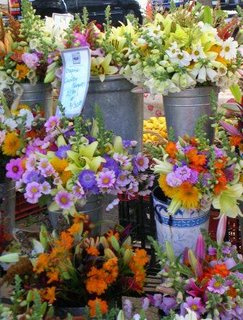
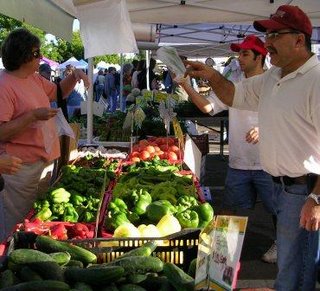
For those of you who did not go to the Cherry Creek Farmer's Market this morning, this is just a sampling of what you missed! No better way to start the weekend, my friends!
Time to Buy Bulbs

It happens every year. Spring rolls around and we fall in love with the beautiful daffodils, tulips, crocus, and snowdrops that seem to be blooming everywhere. And we kick ourselves for not planting some in our own gardens the previous Fall. Head over to your garden center now for the best selection. You will be amazed at the wonderful assortment of both major and minor bulbs --- if you shop early. Don't plant yet though! Store your bulbs in a cool place until the average daily temperatures drop to about 65 degrees. Planting time in our area runs from mid October through November.
I'd love to hear about some of your favorite bulbs, especially those that are long lasting. Just click on "comments" below.
Meet . . . Zauschneria!


Now say that three times as fast as you can! This long blooming perennial is commonly referred to as Hummingbird Trumpet or California Fuchsia, but I prefer to use the botanical name, Zauschneria, for clarity. The tall (3') form, Z. arizonica, is quite drought and heat tolerant, once established. It blooms in my garden from late August into fall. The lower form, Z. garretti, is great in rock gardens or along walkways. It is not quite as drought tolerant, but is much longer blooming---from July through fall. Both of these plants feature hummingbird attracting orange trumpet-shaped flowers. They prefer well drained soil and a good half to full day of sunshine.
The strong orange flower color of Zauschneria calls for companion plants with strong colors as well. Try Missouri evening primrose, globe thistle, 'Moonshine' yarrow or blue avena grass.






